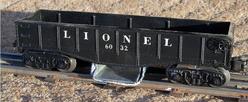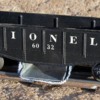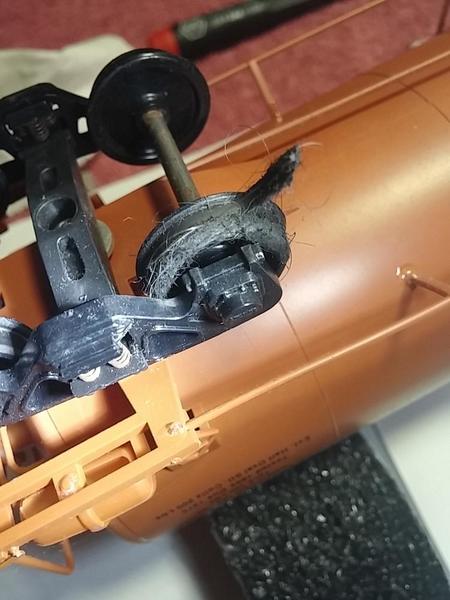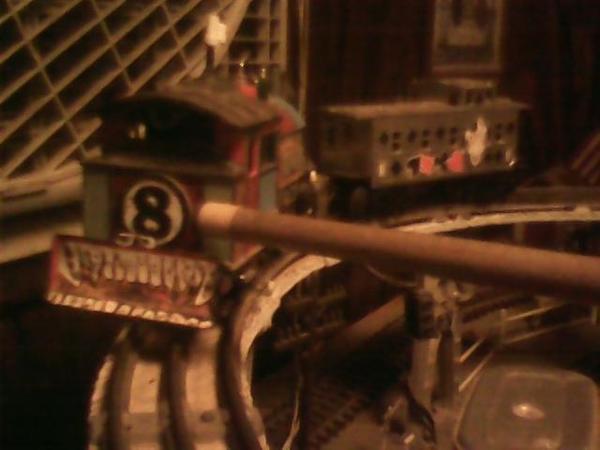Have read a good bit about cleaning engine wheels under power with engine in a cradle. This seems much better than my current method of using a Q-tip which is difficult because I cant reach everything. Does anyone have any suggestions on how to best do this. Do MTH engines have to go through start up and then run conventionally? Any help appreciated. thanks speperak
Replies sorted oldest to newest
Give an MTH loco conventional power and it will start up in conventional (after it determines there is no DCS signal). An MTH unit with a ProtoSound 3 board will wait a few seconds in silence while the onboard super-capacitors charge up, then also start-up.
Both will require a momentary interruption in power to begin running in forward.
---PCJ
Find a box you like, wood, cardboard, whatever.... line it with foam, bubble wrap etc, and lay a cloth over it
.
I like cloth that can be removed and washed vs a fancy store bought one. It also catches oil and cleaning fluid spills that might melt foam ??
Some details should be accounted for and that's were foam alone outperforms.
I just. use a miter box mostly, but if a cardboard box will work, why not? ![]()
You still need Q-tips; buy bulk. ![]() .
.
I have an easier way. It works well based on the number of cars that the loco will pull after I clean the wheels.
I use a gondola and a pad of paper towels fastened to the car with rubber bands. Make the pad thicker in the middle than at the ends so the rubber bands can hold it on the car without touching the rails. Put some alcohol on the paper towels and put the gondola behind the loco. Run the train. You can add some more cars if you want to, and they will get their wheels cleaned, also. Run the train and check the towels periodically for dirt. When the towels get dirty, turn them to a clean surface or replace them. The rails will clean the loco wheels and the paper towels will clean the rails. You may have to run the train for a couple of hours depending on the size of your layout. I did this recently and some guys on the forums were amazed that the little loco I had would pull so many cars after I cleaned the rails. The loco was a single motor Alco with Magnetraction. I think it was pulling more than 20 cars, some of which were post war cars which have a lot of friction in the wheel bearings even if they are oiled.
You can use cue tips if you want to, but if you don't clean the track you are wasting your time.
I clean rusty track the same way. I put the e unit in forward only and run the train until there is a shiny stripe down the center of each rail. Then I put the e unit in operation and it works just fine. Just another way to make things work well by running the train which I thought was the whole idea of toy trains/model railroading. Niche wahr? Pravda?
Another method for cleaning the metal wheels on O-gauge locos and train cars ...
Use the small metal brush accessory chucked into a hand-held DREMEL tool and lightly apply it to the wheels all around. This will remove the stubborn black gunk from the wheels without using messy chemicals and will produce a polished surface.
There are many Track Cleaning Cars in the marketplace, but IMHO none are as effective as a clean terrycloth hand towel doused with 91% Isopropyl Alcohol and applied with "elbow grease." Fold the cloth often as you go to avoid merely redistributing the rail gunk along the right of way. Then wipe the tracks dry. Some hobbyists prefer a citrus-based cleaning product, like GOO BE GONE. It works too, and the citrus odor soon disappears.
Sluggish locos respond well to cleaning!
Mike M.
It has been mentioned in previous discussions that certain steam engines should not be ran upside down because side rods can bind. Gunrunner John noted this several times. Does anyone know what era or model of engine this applies to? Is it safe to run newer MTH steam engines upside down? Just being cautious. thanks speperak
Mike H Mottler posted:Another method for cleaning the metal wheels on O-gauge locos and train cars ...
Use the small metal brush accessory chucked into a hand-held DREMEL tool and lightly apply it to the wheels all around. This will remove the stubborn black gunk from the wheels without using messy chemicals and will produce a polished surface.
Definitely lightly. Wear eye protection. I was cleaning stubborn wheels once and too much pressure results in the metal bristles flying out and sticking in yor skin and clothes like tiny knives!
Train Nut posted:Mike H Mottler posted:Another method for cleaning the metal wheels on O-gauge locos and train cars ...
Use the small metal brush accessory chucked into a hand-held DREMEL tool and lightly apply it to the wheels all around. This will remove the stubborn black gunk from the wheels without using messy chemicals and will produce a polished surface.
Definitely lightly. Wear eye protection. I was cleaning stubborn wheels once and too much pressure results in the metal bristles flying out and sticking in yor skin and clothes like tiny knives!
WARNING !!! Those Dremel-type mini wire wheels are real handy for cleaning certain items but I NEVER USE THEM INSIDE MY HOUSE because the tiny wires go flying everywhere as they wear with regular use. They can get stuck in your clothes and socks and carpet and later turn up as tiny splinters in your skin!
I use them outdoors and wear a work apron to keep the stray wires out of my clothes. WEAR EYE PROTECTION !!!
If wheels have build-up of thick gunk, I first soften it with a cleaning solvent then scrape the bulk of it off with a sharpened wooden stick, then use the wire wheels for final polishing (and get more mileage out of them).
I advocate regular use of home-made track cleaner cars to minimize the need to clean wheels.
I use the Dremel but yes as stated wear safety glasses and don't do it over carpet ect. I use mine at my work bench/area.
I use the Dremel also, however I use the buffing pads / wheels. Not as aggressive as the wire brush but no danger of flying wire shrapnel. The buffing pads can also be used on track and switches without danger of wire pieces being picked up by magne-traction engines.
Bruce
Just a thought about the flying wires coming off the wheels. You could use a piece of wood cut to the right height with a very strong magnet placed on top of the wood. Line up the magnet where the wires would fly off the wheel and the magnet should attract them and they would not be flying everywhere. I have never tried it but in theory I believe it should work. Choo Choo Kenny ![]()
Choo Choo kenny posted:Just a thought about the flying wires coming off the wheels. You could use a piece of wood cut to the right height with a very strong magnet placed on top of the wood. Line up the magnet where the wires would fly off the wheel and the magnet should attract them and they would not be flying everywhere. I have never tried it but in theory I believe it should work. Choo Choo Kenny
Brass and stainless steels are mostly non-magnetic. I think the drremel wheels are often made of one or the other because thin steel with a high iron content is going to rust away sooner if used for bristles.
You could test them easy enough, but remember the shank might be what's magnetic, check carefully..
In the shop, on bigger wheels that are magnetic, your method is sound. We used old speaker magnets on worn broom heads to pick up screws and bolts to save from ventilation duct installs. It leaves the dirt behind and therefore out of your stock.
When I use a Dremel wire wheel, I usually work inside a box that I hole between my knees and I keep the Dremel tool vertical so the wires stay inside the box. The wires break off due to metal fatigue. They are constantly being bent and straightening out as the wheel rotates. This flexing causes metal fatigue. Depending on the stress level, the wires could break after only a few thousand flexes.
servoguy posted:You can use cue tips if you want to, but if you don't clean the track you are wasting your time.
Good point. It does not solve anything to clean the wheels and then place them back on track that has residue from rubber traction tires and from smoke units.
Number 90 posted:servoguy posted:You can use cue tips if you want to, but if you don't clean the track you are wasting your time.
Good point. It does not solve anything to clean the wheels and then place them back on track that has residue from rubber traction tires and from smoke units.
Yes, regular use of track cleaners will minimize the need to clean wheels and is much less work in the long run. I run home-made track-cleaner cars in most of my trains, which use disposable wipers of denim cloth material cut from worn-out pants. I know they work because the material gets visibly dirty from sliding on the rails.
Attachments
ACE that's a great idea, very resourceful.!![]()
I quit using the wire bushes in my Dremel for the reasons stated by others. Thanks to a fellow club member who worked for 3M, I now have a lifetime supply of 3/4" 3M Radial Bristle Cleaning and Polishing Discs normally used in making jewelry. They work as well as wire ones but can be used on plastic wheels without fear of gouging or melting the plastic.
Attachments
Those plastic wheels work much better than I ever expected them to. Ive used the full sized types before. The dremel size is new to me.though, thanks for showing off!
It's funny, I had never cleaned my my childhood track. Not once in 40+ years. It came out in Nov or Dec and stayed set up till at least March, to late as July 4th. & never missed a year, never had a running issue.
That same track moved to a layout now needs cleaning about monthly.
The house isn't any dirtier today than it was when I was a kid, carpet or wood have both been the flooring for use on the floor and table both.
I run them more now at times, less often others and it doesn't seem to matter the track will get dirtier on the layout, and running suffers.
I have less sticky goo on my hands today and even handle things better.
My conclusion is our youthful innocence protects the rails and our adult nastiness rubs off and is collected by our trains and so we must stop aging while they run
Instinctively we know this, and try to collect and run as many trains as possible. But are still missing a little part of the equation to run the aging clock backwards.
Back to the lab.
That or...
God runs a floor layout and we need to follow the example for clean running with less derailment.
![]()
Ace posted:Number 90 posted:servoguy posted:You can use cue tips if you want to, but if you don't clean the track you are wasting your time.
Good point. It does not solve anything to clean the wheels and then place them back on track that has residue from rubber traction tires and from smoke units.
Yes, regular use of track cleaners will minimize the need to clean wheels and is much less work in the long run. I run home-made track-cleaner cars in most of my trains, which use disposable wipers of denim cloth material cut from worn-out pants. I know they work because the material gets visibly dirty from sliding on the rails.
The only reason I haven't used the cleaning cars I've made bef
Round two...
The only reason I haven't used the cars Ive made before was the pads I used or made left behind enough material to require clean up of that as well; hand cleaning wasn't much slower on my 4x9 . But I bet the denim would work great!
GREAT PRODUCT idea -- 3M plastic polishing cleaning discs. Now to find them ... I buy Dremel accessories at the nearby Lowe's big box store. I'll look there first. I'll also search for the 3M discs online too.
Mike M.
I have seen them for sale on Micro-Mark's website, but if you Google "3M Polishing Discs" there are numerous vendors out there. These can be pricey so shop around. I have never had to buy any, but conceivably will one day run out and need to do the same. Good luck!
Dean
Pricy but they last a long time in my experience. So does that expensive sandpaper if you don't let it load uP ( knocking Paper clean every few seconds extends the life of most sandpapers, those "spots of dust" will wreck a fine finish too)
I couldn't post this before as attempts marked the beginning of the end for that computer. But I'm still laughing at cleaning with "cue tips" even when I clean my ears, so I thought I'd try to work it out of my system by sharing my fun with the "how NOT to" photo I took that night.












